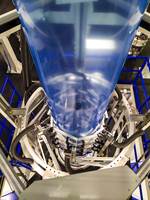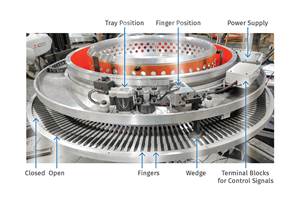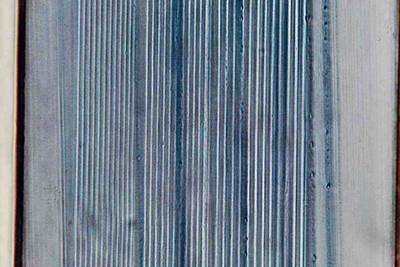Compact Line Turns Blown Film Processing Upside Down
Space-saving blown film line blows bubble down and is height-adjustable to optimize film temperature for the material.
BBS Corp., which since its inception more than 20 yr ago has focused on developing nanolayer blown film dies, has branched out to complete systems with an altogether new type of blown film line. The company, run by Hank Schirmer, who retired from Cryovac Corp. (now Sealed Air) as the director of new technology, will be forming a company called American Nano Technology (ANT) to commercialize the patented technology and is building a plant in Boiling Springs, S.C., to assemble systems.
Schirmer is named on more than 100 patents, including one for a new kind of nanolayer die. Also named on the patent are Matthew Hampshire and Blaine Trivette, a machine-tool business owner who will be a principal of the ANT film operations, which will have a machine shop to make nanolayer dies.
BBS calls the new system a Polygonal Film Line. As Schirmer explains, it’s a space-saving downward blown film line that, in its lab in Spartanburg, S.C., is furnished with an 8-in. nano-layer die and air ring. When commercialized, BBS plans on offering the system with 1.5-in. Davis-Standard extruders tilted upward at a 45° angle, forming a polygon. The extruders are equipped with torque-driven motors. This reduces the weight of the extruder because no gear box is required. It also provides the power necessary to push the polymer feed “uphill” at an angle. The line is compact, sturdy and eliminates the floor space required for the tower structures in typical blown film lines.
Downward blown film lines are commercially available to produce water-quenched films or to blow low-melt-strength materials such as PP and PET.
The Setup
As BBS’ patent details, the setup includes a support frame, at least four upright support elements, at least two lateral support elements and one or more longitudinal support elements (see illustration). Each of the lateral support elements is joined to at least two of the upright support elements. The support frame can also be furnished with mounting pads connected to the first and second lateral support elements that can be pivotally connected to the lateral support elements to manipulate the angle between the extruder and die.
“The ability to vary the height or bubble length is very useful in achieving the optimum film temperature for converging without wrinkles.”
Because the support elements are interconnected, a motor-driven pulley and cables can be used to raise or lower the entire platform, as well as the extruders and die supported by it. The support frame can withstand loads to 10 tons or more, depending on the complexity of the line.
The converging section and surface-driven winder are on a rotating turntable driven by a small variable-speed motor. This turntable has an electrical slip ring in the center that powers the variable-speed pinch roll as the turntable is slowly rotating. This produces a flat roll profile without tangled wires or the need to oscillate the film, Schirmer says.
“The ability to vary the height or bubble length is very useful in achieving the optimum film temperature for converging without wrinkles,” Schirmer explains. “That is the main reason for the lift. Cooling the bubble is another reason. If the film is wound too hot, it will block and be difficult or impossible to unwind. So, in this case, the bubble is made longer by raising the lift to cool the bubble more.” The maximum height is 32 ft.

Schematic of BBS’ adjustable-height, downward blown film line.The space-saving line can be raised up to 32 ft and targets specialty film processors or food-processing companies that want to make their own film on demand. Images courtesy of BBS.
He elaborates, “Some specialty films use materials with glass-transition temperature (Tg) above room temperature, and these materials cause the film to be pretty stiff at room temperature, and stiffness is a common cause for wrinkles during converging and winding. So there always is a sweet spot where you can get the best quality film at a temperature near the Tg of the stiff material. For example, polycarbonate has a relatively high glass transition temperature, and if this material is part of the film structure, the bubble should be converged hot. Because the Polygonal Film Line is a downward film process, filling the bubble with water at the nip rolls provides hydrostatic outward pressure against the bubble during converging. This is advantageous because it assists converging the stiffer bubble into wrinkle free film both in hot bubble and cold bubble situations.”
Target markets for the new system include specialty film converters and food-processing companies that may want may the option to make their own packaging film on demand. Schirmer says BBS produced nylon-free barrier films on its first mockup line using a 4-in. die to make nanolayer films 13- to 16-in. wide. “This is important because we then can extrude at a lower temperature and this, in turn, yields a higher-quality film and permits weaving EVOH into more complicated film structures.”
Schirmer says nylon 6 is not a high-oxygen-barrier material and has a high melt temperature, at about 460-500 F. He notes it is generally used because of its thermoforming characteristics, and does require water quenching prior to forming. He adds if nylon 6 is used in combination with EVOH, the melt temperature of nylon 6 will tend to degrade the EVOH, which he says runs best at 400 F. “So this lower processing temperature tends to make higher-quality film, and eliminating nylon 6 permits lower processing temperatures,” Schirmer notes.

BBS has purchased a dozen used 1.5-in. Davis-Standard extruders for use on two six-extruder film lines at its new Boiling Springs location.
He adds, “Our barrier film formulations made on this equipment will thermoform very easily. This ability, then, puts the focus on barrier films that can be run on a vacuum packaging machines. EVOH is well known to be a temperature-sensitive resin that is best handled in streamlined dies without much residence time. In preliminary tests, we have shown our ability to process this barrier resin in multiple nanolayers for our thermoforming films. Multiple nanolayers of EVOH are less prone to flex-crack failure. Using a Gelbo Flex Tester, barrier properties were still retained after 500 cycles. We encourage others who may use other nanolayer dies in the future to look very closely at making barrier films more abuse resistant by using this method.”
Related Content
New Blown-Film Cooling Technologies Set to Debut at NPE2024
Cooling specialist Addex to roll out new auto-profiling air ring for rotating dies, and new single-plenum air ring.
Read MoreScaling Up Sustainable Solutions for Fiber Reinforced Composite Materials
Oak Ridge National Laboratory's Sustainable Manufacturing Technologies Group helps industrial partners tackle the sustainability challenges presented by fiber-reinforced composite materials.
Read MoreFor Extrusion and Injection-Blow Molders, Numerous Upgrades in Machines and Services
Uniloy is revising its machinery lines across the board and strengthening after-sales services in tooling maintenance, spare parts and tech service.
Read MoreBreaking News From NPE2024
Here is a firsthand report of news in injection molding, extrusion, blow molding and recycling not previously covered.
Read MoreRead Next
All-Nanolayer Disk Die Pushes Blown Film Layer Limits
Patented die aims to extend blown film layer limits beyond the current nine- and 11-layer standards currently considered high-tech.
Read MoreNovel Line Produces 27-Microlayer Blown Film
Italian machine builder unveils blown film system that relies on feedblocks—far more common in flat-die processing—to yield thin yet strong film.
Read MoreNano-Layer Shrink Film: Strong But Thin
Ultra-thin stretch-oriented blown shrink film now can be processed using the Layer Sequence Repeater (LSR) technology developed by BBS Corp., Spartanburg, S.C.
Read More






















